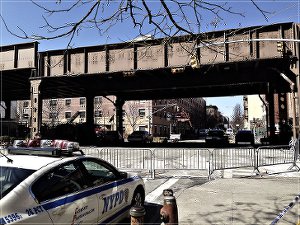

Site of gas explosion in East Harlem.WW photo: Johnnie Stevens
While investigations into the cause of fatal explosions in New York’s East Harlem and East Village are still in progress, a couple of things are certain. These so-called accidents are happening more often, and there are potential dangers from gas blasts everywhere.
The March 26 explosion on Second Avenue in the East Village, which left two people dead, injured 22 and destroyed three buildings, was the latest incident in a dangerous trend involving gas and gas pipelines.
From 1994 to 2013, the United States had 745 serious disasters with gas distribution, causing 278 fatalities, 1,059 injuries and over $110 million in property damage. During that period an additional 110 incidents through gas transmission caused 41 deaths, 195 injuries and over $448 million in damage to property. And an additional 941 incidents from gas of all system types resulted in 363 deaths, 1,392 injuries and close to $824 million in property damage. (nhpipelineawareness.org)
Criminal prosecutors and the police believe the explosion in the East Village may have been caused by continued tapping of a gas line. Criminal charges could be filed as a result of the explosion.
Members of Utility Workers Local 1-2 were part of the first responders’ team — along with the New York Fire Department, Police Department and emergency medical technicans — to secure the area by shutting down the gas systems, a representative of the union told Workers World.
Meanwhile, displaced tenants are seeking legal counseling and compensation for their losses. A meeting to inform them of their housing and personal property damage rights brought more than 100 victims of the blast together with lawyers and housing activists.
Wasim Lone, director of housing services for GOLES (Good Old Lower East Side), said the group is actively working to provide legal counseling and representation to displaced tenants, as well as tenants who have not lost their buildings but have notices to vacate.
Many of the tenants who lost their apartments and personal property focused on the landlords of the buildings. But Thomas M. Curtis, lawyer for the landlord of two of the buildings, told the April 1 New York Times that Consolidated Edison was to blame.
“I think Con Ed is really culpable here for not shutting off the gas,” said Curtis. He added, “[The utility] could have shut off the main valve.” At the meeting, attorney Arthur Schwartz urged the tenants to “look at the broader picture.” He continued, “There can be multiple defendants. I believe Con Ed may have some blame here.”
In a phone interview with Workers World, Michael McKee, treasurer of the Tenants Political Action Committee, said, “It seems that there was something definitely wrong in the inspection of the site of the explosion. Something is wrong if Con Ed didn’t smell any gas there.”
Johnnie Stevens, of the People’s Power Assembly, agrees. Stevens mobilized an ad hoc group of housing and environmental activists following the gas explosion disaster in East Harlem last year. The group called on the National Transportation Safety Board, which is investigating the Harlem explosion, to fully investigate Con Ed and use its authority to hold a public hearing in East Harlem. The group is now demanding that Con Ed be fully investigated for both explosions.
Rosa Maria de la Torre, organizer of the Chelsea Coalition on Housing, said the hearing must determine what should be done to provide adequate housing for the survivors of the explosion.
Turning to the East Village blast, de la Torre said, “I am horrified by this tragedy and the deaths and the destruction it has caused. But with the growth of pipelines, there are potential catastrophes everywhere.”
One of these pipelines, which lies under the West Village and Chelsea, won federal approval to start pumping natural gas despite strong opposition by residents of the area, who fear the project could cause an explosion and environmental contamination. The gas is distributed by Con Ed to Manhattan customers.
The new Whitney Museum, which opens this spring, sits on top of the Spectra pipeline. The Sane Energy Project, which opposed approval of the pipeline, warned of the potential catastrophe in a March 12 letter to the Villager.
“Building the Whitney on top of the pipeline puts visitors, workers and irreplaceable art, not to mention the Renzo Piano creation, at risk,” wrote Claire Donahue, program director of Sane Energy. “In the event of an explosion at the site of the vault, a crater at least the size of the museum itself is likely, and would affect an area about a block and a half in radius, with smoke, broken glass, closed streets and secondary fires affecting a much larger radius.”
A funeral service for Nicholas Figueroa, one of the two men killed by the explosion in the East Village, was held on April 7.
Littman lives in the area near the Spectra pipeline.
The epic struggle of the Palestinian people against the full weight of U.S. imperialism and…
The following report comes from the Bronx Anti-War Coalition organizers on a protest held in…
In the Canadian federal elections held on April 28, the Liberals won with 169 seats…
The following is Part 2 of a talk given by the author to a meeting…
Boston Students, professors and workers are confronting the Trump administration’s fascist crackdown at universities across…
Philadelphia Within days of Swarthmore students reviving a pro-Palestinian encampment on April 30, police arrested…